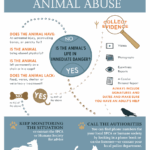In an era characterized by heightened awareness of social justice, it is perplexing that animal cruelty continues to be glorified across various domains of popular culture. From blockbuster films to viral internet memes, instances of animal suffering have become ubiquitous, leaving many to wonder why society is still entertained, and sometimes desensitized, by the portrayal of such distressing narratives.
Firstly, it is essential to understand that popular culture is a mirror reflecting societal values at any given time. The roots of animal cruelty in media can be traced back to ancient folklore and traditions where animals were often depicted as mere commodities or symbols. These depictions gradually evolved, but remnants of this twilight understanding persist. They manifest in modern storytelling, which typically prioritizes shock value and sensationalism over ethical considerations.
Furthermore, the anthropomorphism of animals in films, television shows, and literature often results in a convoluted moral narrative. When animals are rendered as exaggerated caricatures, their suffering can be stripped of its gravity, transforming them into vessels for human amusement. Iconic characters, designed for entertainment, can inadvertently desensitize audiences—reducing complex creatures to mere plot devices. This normalization of animal suffering can be seen in children’s programming as well, where violence against animals is trivialized as part of humor or adventure.
The impact of digital media cannot be understated. With the internet’s evolution, a plethora of platforms proliferate content that glamorizes violence against animals. Social media encourages virality, and what garners clicks often embodies sensationalism—harrowing images or videos become fodder for misplaced amusement. Viral challenges, sometimes involving the mockery of animals, serve as perfect examples. These demeaning portrayals effectively dilute empathy, obscuring the ethical implications of real-life animal suffering.
In addition, the glorification of animal cruelty in video games has cultivated a generation desensitized to violence against living beings. Many popular games feature depictions of animals in states of distress; these moments are often framed as thrilling or exhilarating. The player’s ability to inflict harm without real-world consequences perpetuates a cycle of desensitization. It not only dulls the moral compass concerning animal welfare but also encourages a culture where violence against any being—animal or human—can become trivialized.
Moreover, celebrity culture frequently entwines itself with a disregard for animal rights. High-profile individuals may be seen flaunting exotic pets or experimenting with blood sports, cultivating a normalization of cruelty that is often glossed over in favor of glamour. Such behaviors can foster a dangerous culture where influencing impressionable audiences becomes a form of tacit endorsement for similar actions. The celebrity’s actions, whether consciously or unconsciously modeled, hold substantial sway—contributing to a culture of desensitization.
The film industry also provides numerous examples where animal cruelty is not only depicted but sensationalized for cinematic effect. One need only look at certain horror films where animals are portrayed in grotesque scenarios to elicit fear or revulsion. These portrayals, often devoid of narrative rationale, instigate a problematic dialogue about the acceptability of featuring animal suffering as a plot device. Audiences are left to grapple with their discomfort, often glossed over in the thrill that these films present.
Amid this chaotic interplay, it is essential to examine our own roles as consumers of this media. While it is easy to cast blame on creators and producers, the frequency of such portrayals indicates a market demand. Audiences, often complicit in these cultural phenomena, contribute through viewership. The irony is palpable; while many express an affinity for animal rights, they still engage with content that contradicts these values. This dichotomy raises an unsettling question: how can one advocate for animal welfare while simultaneously consuming media that vilifies it?
However, the tide is slowly beginning to turn. There are voices in the backlash against these prevailing narratives. Increasingly, there are creators, journalists, and influencers who prioritize the ethical treatment of animals in their works. Documentaries that shed light on the realities of animal suffering in various industries—be it entertainment, fashion, or food—are gaining traction. These informational resources seek to illuminate the moral obligations inherent in our choices as consumers.
In conclusion, as we dissect the layers of animal cruelty glorified in popular culture, it becomes evident that the intersection of media, desensitization, and societal values creates a complex tapestry. The prevalence of sensationalism in storytelling, facilitated by advancements in technology, contributes to a troubling narrative that undermines the ethical treatment of animals. It is imperative for audiences to cultivate critical viewing habits, acknowledging not only the influence of media but also their role within it. By actively seeking content that uplifts and advocates for animal rights, society can begin to dismantle the frameworks that accommodate glorification of cruelty. Only then can we hope to evolve towards a culture that recognizes and respects the intrinsic value of all living beings, thereby fostering empathy, understanding, and advocacy for our fellow creatures.





